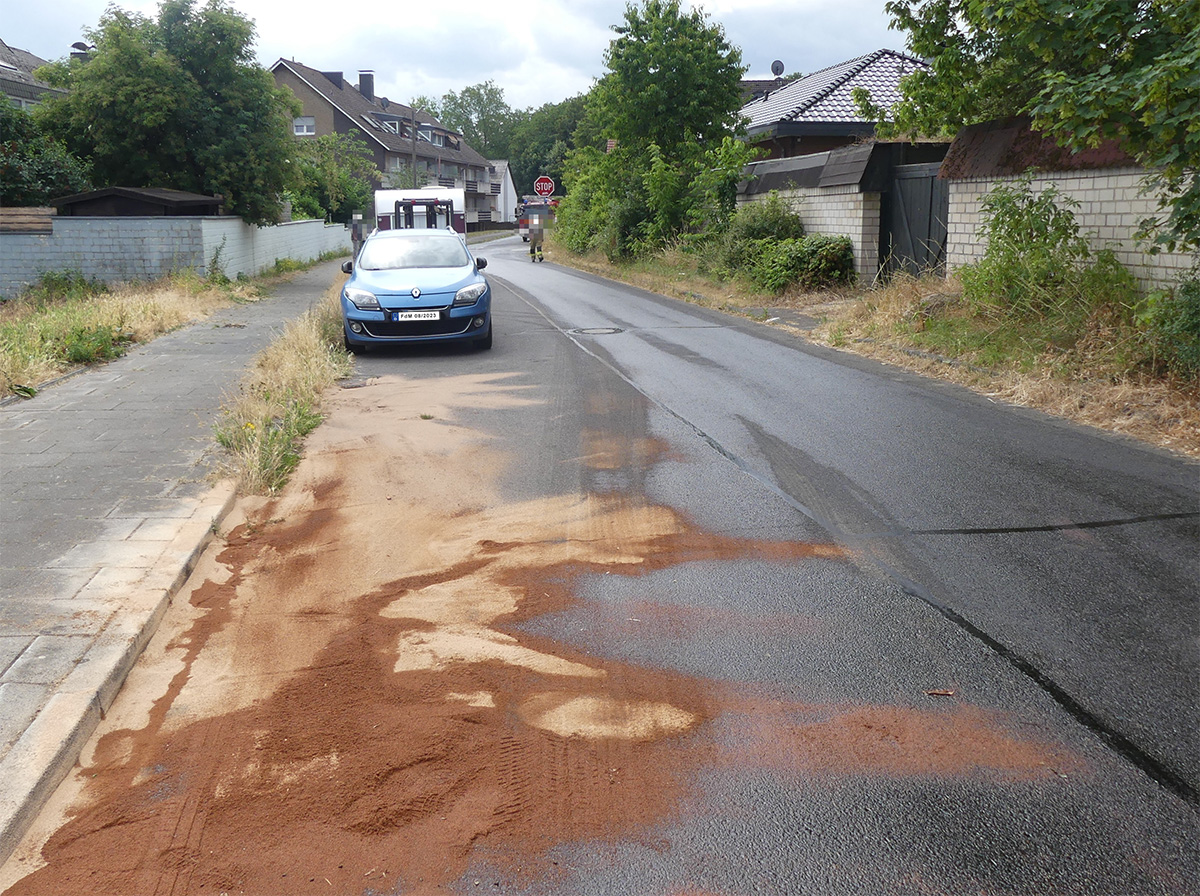| Photo of the month – August 2023 |
[German version] |
The oil slick!
Or
Just give it a try, it’s sure to work…but it didn’t!
In Figure 1, we can indeed see an oil spillage that truly deserves to be called a slick. As load securing columnists,we are always ready with a clever turn of phrase. But deep down, we always look at things much more closely. In this Photo of the Month, some of our fellow human beings have gone to great lengths to put their good fortune to the test. And for a moment, their guardian angels looked the other way and that’s when it all went wrong. To cap it all, a scooter rider also skidded on the oil and suffered minor injuries. And things could have turned out much worse. At least one piece of good fortune!

Figure 1 [Bonn police / Bornheim fire service]
Just to make things doubly clear, here is a second photo of the ‘oil slick’. A small cause with a massive effect.

Figure 2 [Bonn police / Bornheim fire service]
The way this load was secured was somewhat casual, poorly thought through, and creative. Yes, it was an oil tank and, yes, an attempt at something resembling load securing was made. But as the results show, it wasn’t the greatest of ideas.

Figure 3 [Bonn police / Bornheim fire service]
This was the oil tank but just because it can be used to store fuel oil, it is far from being suitable for transporting this material which, incidentally, is also classified as a hazardous substance. The containers used to transport hazardous substances must be approved for this purpose and that was certainly not the case here. At the side, this tank is in danger of tipping and there is also a risk of this at the front, especially if the load can move relatively freely in the container.

Figure 4 [Bonn police / Bornheim fire service]
Here is a view inside the trailer that was used to transport the tank … and there’s no sign of any load securing points. The tank was standing on a pallet where it was also “secured” – but we do not know exactly how this was done.

Figure 5 [Bonn police / Bornheim fire service]
In Figure 5, we can see the “belt” that was clearly used in an attempt to “secure” the tank. The tear appears to be recent and, as if that weren’t enough, we can see a knot in the belt on the left-hand side of the photo. Even with the best will in the world, we can see nothing more than a feeble attempt to give the appearance of having done something in the cause of “safety”. Without this goodwill, the attempt to secure the tank would have to be considered laughable and the transport operation culpably negligent.
So what happened?
The vehicle that was towing this trailer had to brake quite sharply and the tank slipped off the pallet and tipped over. Unfortunately, this also damaged the lid of the tank, releasing large quantities of fuel oil. This was not noticed immediately, allowing the oil spillage to turn into a veritable slick.

Figure 6 [Bonn police / Bornheim fire service]
Here is the broken lid of the tank.
Securing the load:
Here is some basic information on transporting fuel oil as of a certain volume:
- The tank must be approved.
- The vehicle must be identified as transporting this load.
- The load securing measures must be exemplary and secure beyond any doubt.
- The driver must have been appropriately trained (ADR dangerous goods license).
- In addition, the vehicles are subject to certain requirements in terms of their equipment and the associated construction regulations.
But now let’s imagine that a gardening company that has been given the task of watering a number of freshly planted trees in the summer wants to transport water.
- As we almost always do, let’s start with the friction. We would underlay the entire surface area of a tank of this sort with anti-slip material.
- Because the load (water) splashes around, i.e. moves dynamically in the tank, we would secure the tank as if it had no friction.
- Under no circumstances should the tank itself be transported upright and it should instead be lying down.
- These tanks are (or, at least, may be) familiar; they are often oval and relatively flat and have a “dome”.
- They are secured as a tight fit and/or with direct lashings in all directions.
- It would be an advantage if the tank had recesses into which the belts could be fitted or threaded.
- One essential precondition is, of course, that the vehicle possesses adequately dimensioned load securing points.
- Let’s consider a 3000-liter tank, which we secure in the direction of travel using one loop lashing.
- To the side, we use four loop lashings to prevent the tank from twisting in its secured position.
- In addition, the four loop lashings (two to the right and two to the left) also perform the task of providing the minimum securing force thanks to their tie-down effect.
- Because we want to secure the tank as if it had no friction, we also use a loop lashing to the rear.
- A word of warning! You will often see such tanks secured around the “dome”. Please make sure first that the tank dome is able to withstand the stresses.
Your load securing columnists wish you a relaxing, safe and secure summer!
Back to beginning
